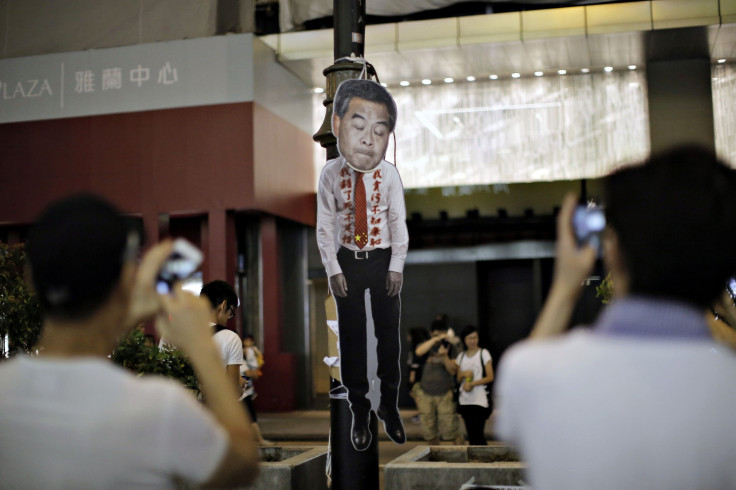Hong Kong Street Clashes Continue Despite Imminent Talks

HONG KONG (Reuters) - Violent clashes erupted in Hong Kong early Sunday for the second time this weekend, deepening a sense of impasse between a government with limited options and a pro-democracy movement increasingly willing to confront police. The worst political crisis in Hong Kong since Britain handed the free-wheeling capitalist city back to China in 1997 entered its fourth week with no sign of a resolution despite talks between the government and student protest leaders scheduled for two hours Tuesday.
Beijing has signaled through Hong Kong’s leaders it is not willing to reverse a decision in August that effectively denies the financial hub the full democracy the demonstrators are demanding.
“Unless there is some kind of breakthrough in two hours of talks on Tuesday, I’m worried we will see the standoff worsen and get violent,” Sonny Lo, a professor at the Hong Kong Institute of Education, told Reuters. “We could be entering a new and much more problematic stage. I hope the government has worked out some compromises, because things could get very difficult now.”
Hong Kong’s 28,000-strong police force has been struggling to contain a youth-led movement that has shown little sign of waning after three weeks of standoffs.
Demonstrators in the Mong Kok district launched a fresh assault early Sunday, putting on helmets and goggles before surging forward to grab a line of metal barricades hemming them into a section of road. Hundreds of police officers hit out at a wall of umbrellas that protesters raised to fend off police pepper spray. Demonstrators screamed and hurled insults as violent scuffles erupted before police surged forward with riot shields, forcing the protesters back.
“Black Police! Black Police!” demonstrators shouted. One activist in a white T-shirt and goggles was hit with a flurry of baton blows, leaving him bleeding from a gash in the head. Several protesters were taken away.
A senior policeman at the scene, Paul Renouf, said between 400 and 500 officers were deployed to force the crowd about 20 meters (about 22 yards) back from its original position near an intersection.
Dozens of people were reportedly injured in the two nights of clashes, including 22 police officers. Four people were arrested early Sunday, police said.
The clashes came hours after Hong Kong’s pro-Beijing leader Leung Chun-ying called for the talks Tuesday. They will be broadcast live.
Restive Generation
The demonstrators, led by a restive generation of students, have been demanding China’s Communist Party rulers live up to constitutional promises to grant full democracy to the former British trading outpost.
Hong Kong is ruled under a “one country, two systems” formula that allows it wide-ranging autonomy and freedoms and specifies universal suffrage for Hong Kong as an eventual goal.
But Beijing is wary about copycat demands for reform on the mainland, and it ruled Aug. 31 it would screen candidates who want to run for the city’s chief executive in 2017. Democracy activists said that ruling rendered the universal suffrage concept meaningless. They are demanding free elections.
Leung appears hamstrung, unable to compromise because of the message that would send to people on the mainland while more force looks likely to only galvanize the young protesters.
Hong Kong’s Security Chief Lai Tung-kwok said some of the clashes in recent days had been initiated by activists affiliated to “radical organizations which have been active in conspiring, planning and charging violent acts.” The city’s embattled police chief, Andy Tsang, also expressed his frustration when he broke three weeks of silence Saturday to say “extremely tolerant” policing had not stopped protests becoming more “radical or violent.”
The demonstrations pose one of the biggest challenges for China since the crushing of a pro-democracy movement in Beijing in 1989.
The situation in Hong Kong surfaced in weekend talks between U.S. Secretary of State John Kerry and Chinese State Councilor Yang Jiechi in Boston.
A senior State Department official said Hong Kong was discussed as part of “candid exchanges” on human rights while a Chinese Foreign Ministry statement said Yang had told Kerry that no country should interfere in Hong Kong, “purely an internal affair of China.”
In Mong Kok, protesters resting during the day Sunday were defiant and also angry that the city government was portraying their campaign as increasingly radicalized and violent.
Lap Cheung, 40, said he quit his information-technology job in the U.S. to return to Hong Kong to join the protests when he heard a student leader had been arrested three weeks ago. “I will continue to stay here until CY [Leung] resigns,” he said, adding that he had no hope for Tuesday’s talks.
Student Igloo Novas said Hong Kong leaders must tell Beijing the “truth,” meaning that the majority of Hong Kong people wanted to freely choose candidates in elections. “This is one compromise I can accept from the government,” she said.
While police took down some banners and posters, they left one of the more dramatic and popular of them: a cardboard cutout of Leung being hanged in effigy from a lamppost.
Besides the crowd in Mong Kok, about 1,000 demonstrators remained camped out on Hong Kong Island in a sea of tents on an eight-lane highway beneath skyscrapers close to government headquarters.
(Reporting by James Pomfret and Elzio Barreto; Additional reporting by Yimou Lee, Clare Jim, Irene Jay Liu, Twinnie Siu and Diana Chan and Benjamin Kang Lim in Beijing; Writing by Greg Torode; Editing by Robert Birsel and Clarence Fernandez.)
© Copyright Thomson Reuters 2024. All rights reserved.











